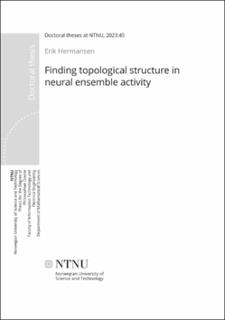| dc.contributor.advisor | Dunn, Benjamin | |
| dc.contributor.advisor | Baas, Nils A. | |
| dc.contributor.author | Hermansen, Erik | |
| dc.date.accessioned | 2023-02-06T11:53:12Z | |
| dc.date.available | 2023-02-06T11:53:12Z | |
| dc.date.issued | 2023 | |
| dc.identifier.isbn | 978-82-326-5627-1 | |
| dc.identifier.issn | 2703-8084 | |
| dc.identifier.uri | https://hdl.handle.net/11250/3048547 | |
| dc.description.abstract | Finding topological structure in neural ensemble activity
Recent breakthroughs in electrophysiological recordings and calcium imaging have unlocked the potential for understanding how groups of neurons work together. However, the amount of data and the complexity of the brain elicits a need for more advanced tools to interpret the data.
In this regard, topological data analysis (TDA) has proven fruitful, revealing topological and geometrical structure in spatially modulated neurons, signifying a step forward in understanding the computations performed by these cells. TDA has seen rapid development in recent years, yet, state-of the-art methods are still sensitive to the noise and size of experimental data.
Here, we investigated the use of topological tools in recorded neural data, specifically developing computational frameworks based on persistent cohomology for finding topological structure in the collective computations of neural ensembles. Through a noise-robust geodesic approximation based on a uniformity assumption, we revealed a toroidal population state space in grid cells – neurons which are highly active in spatially confined regions, forming a hexagonal pattern in a two-dimensional environment. We described the internal organization of the population activity without reference to a specific physical covariate and showed the topology to be preserved across different environments as well as in sleep. This was furthered by, in an unsupervised manner, finding and analyzing the topological structure of ensembles of entorhinal neurons in head-fixed mice, showcasing the potential of TDA in unravelling internal brain dynamics without assumptions about the function of the cells. Moreover, we suggest a novel pipeline for identifying the functional structure of neural ensembles, exploiting the duality in analyzing both spike trains and population vectors – i.e., both the rows and columns of the same matrix – which reveals complementary information.
Oppdage topologisk struktur i nevral populasjonsaktivitet
Gjennombrudd innen elektrofysiologi og kalsiumavbildning for måling av hjerneaktivitet gjør at vi i dag kan få innsikt i store komplekse nettverk av nevroner. Samtidig nødvendiggjør dette avanserte matematiske metoder og modeller for å forstå samspillet mellom nevroner og beregningene grupper av nevroner gjør.
Avhandlingen «Finding topological structure in neural ensemble activity” undersøker hvordan bruk av topologiske metoder kan påvise en topologiske struktur i nevrale populasjoner. Ved utvikling av et analyserammeverk basert på persistent kohomologi påviser arbeidet at aktiviteten til nettverket av gitterceller i hjernen til en rotte er begrenset til en torus. Det vil si at cellene danner en to-dimensjonal, periodisk beskrivelse, eller en «smultring»-lignende representasjon, av rommet rottene navigerer i. Aktiviteten i cellenettverket beholder torus-strukturen i forskjellige miljøer og under søvn.
Avhandlingen foreslår også en ny fremgangsmåte for identifikasjon av den funksjonelle strukturen til nevrale populasjoner. ved hjelp av en dualitet mellom korrelasjonsstrukturen til cellene og det rommet nevronenes fyringsaktivitet beveger seg innenfor. Arbeidet i avhandlingen viser at analyserammeverket også er appliserbart i eksperimenter gjort på hodefikserte mus, samt uten tilgang til musenes bevegelsesoppførsel. Vi kan nå si at en torus-struktur finnes i nevrale nettverk i entorhinal cortex, og overraskende nok ser vi at den påviste to-dimensjonaliteten overgår den en-dimensjonale, atferdsmessige oppførselen i eksperimentet. | en_US |
| dc.language.iso | eng | en_US |
| dc.publisher | NTNU | en_US |
| dc.relation.ispartofseries | Doctoral theses at NTNU;2023:45 | |
| dc.relation.haspart | Paper 1:
Hermansen, Erik; Klindt,David A.; Dunn, Benjamin A.
Uncovering 2-D toroidal representations in grid cell ensemble activity during 1-D behavior https://doi.org/10.1101/2022.11.25.517966 - The copyright holder for this preprint is the author/funder, who has granted bioRxiv a license to display the preprint in perpetuity. All rights reserved. No reuse allowed without permission. | en_US |
| dc.relation.haspart | Paper 2:
Vaupel, Melvin; Hermansen, Erik; Dunn, Benjamin A.
A topological perspective on the dual nature of the neural state space and the correlation structure | en_US |
| dc.relation.haspart | Paper 3:
Gardner, Richard J.; Hermansen, Erik; Pachitariu, Marius; Burak, Yoram; Baas, Nils A.; Dunn, Benjamin Adric; Moser, May-Britt; Moser, Edvard Ingjald.
Toroidal topology of population activity in grid cells. Nature 2022 ;Volum 602.(7895) s. 123-128 https://doi.org/10.1038/s41586-021-04268-7 This article is licensed under a Creative Commons Attribution 4.0 International License (CC BY 4.0) | en_US |
| dc.title | Finding topological structure in neural ensemble activity | en_US |
| dc.type | Doctoral thesis | en_US |

